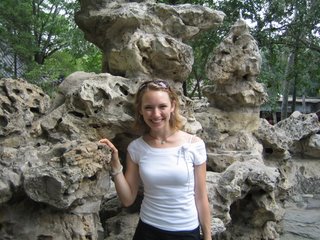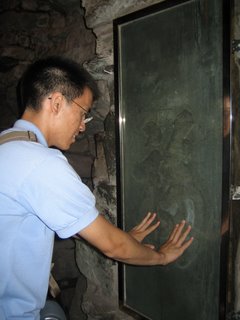The Prince's Palace

Part two of our trip to the Hutongs was an afternoon in the beautiful gardens of an ancient imperial palace. Prince Gong's Palace is the most completely preserved royal residence in existence in China today
 , and consists of the Mansion and the "Garden of Splendor" (also called Cui jin), which, according to the sign which greeted us by the entrance, "implies that it is a collection of unsurpassed beauty and charm." It was certainly charming -- tranquil and beautiful, nestled in the heart of Beijing's most historic hutong district (on the eastern shore of Shi cha hai, one of Beijing's most beautiful lakes, and near Hou hai, the nightlife spot I went to with Sara earlier in my trip). The middle section of the Garden centers around the "Fu Stele," on
, and consists of the Mansion and the "Garden of Splendor" (also called Cui jin), which, according to the sign which greeted us by the entrance, "implies that it is a collection of unsurpassed beauty and charm." It was certainly charming -- tranquil and beautiful, nestled in the heart of Beijing's most historic hutong district (on the eastern shore of Shi cha hai, one of Beijing's most beautiful lakes, and near Hou hai, the nightlife spot I went to with Sara earlier in my trip). The middle section of the Garden centers around the "Fu Stele," on which the Chinese character "fu" (happiness) is inscribed, personally handwritten by Qing Emperor Kangxi in the 1600s. Visitors are invited to mo (stroke) the surface of the character to bring luck, rather like people rubbing John Harvard's foot when they come to
which the Chinese character "fu" (happiness) is inscribed, personally handwritten by Qing Emperor Kangxi in the 1600s. Visitors are invited to mo (stroke) the surface of the character to bring luck, rather like people rubbing John Harvard's foot when they come to Harvard Yard. (Kevin and I both did it -- see the picture of Kev at the left).
Harvard Yard. (Kevin and I both did it -- see the picture of Kev at the left).The rear section of the garden has a multi-leveled artificial hill built of Lake Tai stones. The bottom level has tunnels running through it and contains the "Fu Stele" I mentioned above. On the second level of the garden are two pools where lotuses were blooming and a small wooden boat floating on the pond's placid surface. The eastern courtyard of the garden is surrounded by a low wall and contained all manner of different
 flowers and trees. Screened by the Garden's large man-made hill is the "Hall of Happiness," which was apparently built in such a way that sunlight falls on it from dawn to dusk --said to be the only building of its kind in Beijing at the present time. According to recent research by literary scholars, it was at this Mansion that Cao Xueqin, author of Hong Lou Meng (A Dream of Red Mansions), lived the life he went on to write about in his famous novel about the decline of Chinese feudal society. We stayed at the Prince's Palace for about two hours, before setting out once again for more Hutongs and some further investigation of Beijing's historic architecture.
flowers and trees. Screened by the Garden's large man-made hill is the "Hall of Happiness," which was apparently built in such a way that sunlight falls on it from dawn to dusk --said to be the only building of its kind in Beijing at the present time. According to recent research by literary scholars, it was at this Mansion that Cao Xueqin, author of Hong Lou Meng (A Dream of Red Mansions), lived the life he went on to write about in his famous novel about the decline of Chinese feudal society. We stayed at the Prince's Palace for about two hours, before setting out once again for more Hutongs and some further investigation of Beijing's historic architecture.


<< Home